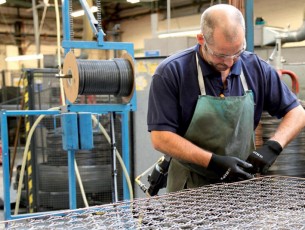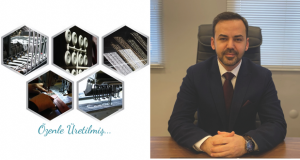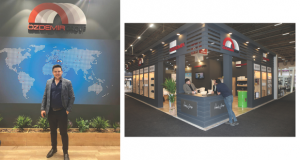Innerspring mattresses remain the most popular type of mattress for decades. They commonly consist of just the spring core, and the top and bottom upholstery layers. This is the type of bed most people picture when they think of a mattress, and indeed spring beds still retain the greatest market share. They have been around since the 1800’s, and little has changed in their manufacturing over the past 100 years.
One of the biggest benefits of choosing an innerspring mattress is that there is a very wide variety you can choose from. Whether you want one that is extra firm or extra soft, you can find it with an innerspring mattress. There are also several different brands that you can choose from, which means you can get a variety of price ranges and options with your mattress, from high-end luxury to budget mattresses. They are also very good for people who like to have several different options for sleep positions, supporting side, stomach, and back sleepers with the right level of comfort.
Spring beds consist of two components: the upper mattress and the lower box spring. Innerspring mattresses are composed of a series of springs or coils, either connected, continuous or pocketed, which exist within a frame, covered with layers of foams, batting and quilting. These types of beds are typically upholstered in various fabrics and can be anywhere from 6 inches to 20 or more in height. The foundation pieces are similarly structured and designed to accompany the mattress layer for added support.
All these mean that this type of mattress consists of a network of hundreds, or even thousands, of coils and springs with varying gauges (thicknesses) and strengths. The stronger the coils, the more firm the mattress will be. The more coils you have within the bed, the better support it will provide for your body’s individual contour. While innerspring mattresses from the old days may have been more likely to sag or get worn down due to weak coils, today’s mattresses are made with steel or titanium coils, individually wrapped so they will last for years.
Typically innerspring beds are also the most affordable. They are also fairly lightweight and easy to rotate or flip. Initially, most spring beds offer decent comfort levels.
Core
The core of the mattress supports the sleeper’s body. Modern spring mattress cores, often called “innersprings,” are made up of steel coil springs, or “coils.”
The gauge of the coils is another factor which determines firmness and support. Coils are measured in quarter increments. The lower the number, the thicker the spring. In general, higher-quality mattress coils have a 14-gauge (1.63 mm) diameter. Coils of 14 to 15.5-gauge (1.63 to 1.37 mm) give more easily under pressure, while a 12.5-gauge (1.94 mm) coil, the thickest typically available, feels quite firm.
The thickness of innerspring wire ranges from the thickest 12.5 gauge to gauges above 16 which are much thinner and less firm although higher gauge thinner coils can shape themselves to a body profile more effectively. While the gauge of innerspring wire and the number of coils in the innerspring are the most commonly used “statistics” of innersprings used to measure its qualities, these by themselves can be very misleading.
All innersprings can be made less or more firm through the use of thicker gauge wire, a greater number of coils, a larger number of “turns” in each coil, tempering, type of steel used, different construction methods, coil shape, coil height, and different insulator layers that are placed on top of them. Bonnell, continuous coils, and offset coils are also joined together with a tightly coiled thinner wire called a helical and different types and designs of these can also make a big difference in how each individual coil is affected its neighbors and the firmness and conforming ability of an innerspring. Pocket coils are kept together through the use of fabric “pockets” which are joined together (rather than the coils themselves being joined) or in the case of higher quality versions by “hand tying” each coil to other coils near it. These pocketed or hand tied coils have more independent movement which gives Pocket coils their greater “shape conforming” ability while the other 3 types act more together in a group with other coils because of the helical connections. All other factors being equal, this gives them greater firmness.
Connections between the coils help the mattress retain its shape. Most coils are connected by interconnecting wires; encased coils are not connected, but the fabric encasement helps preserve the mattress shape.
There are various types of mattress coils:
* Pocket coils in general have the greatest “response range” which means that they can be softer on initial compression and then firmer on deeper compression. They also have the advantage of providing greater “point elasticity” which is the ability to form itself around your body profile.
- Bonnell coils are the oldest and most common. First adapted from buggy seat springs of the 19th century, they are still prevalent in mid-priced mattresses. Bonnell springs are a knotted, round-top, hourglass-shaped steel wire coil. When laced together with cross wire helicals, these coils form the simplest innerspring unit, also referred to as a Bonnell unit. They are the original mattress coil and are a development of wire coils used under seats in horse and buggy days. They have an hourglass shape and can be made with many different wire gauges to make them more or less firm. The reason for the hourglass shape is so the middle thinner part of the spring can compress with softer pressure and then the rest of the spring “engages” with greater pressure to provide support.
- Offset coils are the hourglass type coils on which portions of the top and bottom convolutions have been flattened. These coils share some of the same qualities of Pocket coils and are often used in higher quality mattresses. They are an offshoot of Bonnell coils with a “hinged and shaped (squared) wire” on top which when joined with the coil next to it (with a helical wire) creates a hinging effect which flexes under softer pressure while the main body of the coil “kicks in” with deeper compression. There are several versions including free arm offset and double offset (has a squared off section on each side of the coil). In assembling the innerspring unit, these flat segments of wire are hinged together with helical wires. The hinging effect of the unit is designed to conform to body shape. LFK coils are unknotted offset coils with a cylindrical or columnar shape.
- Continuous coil is an innerspring configuration in which the rows of coils are formed from a single piece of wire. They work in a hinging effect similar to that of offset coils. They are made from one continuous wire made into rows with “simulated” coils in each row. These rows are then attached together with helicals. They are very simple and inexpensive to make because they do not have the expense of forming individual coils and then placing and connecting them inside the innerspring. Because they use a single wire and are “strongly joined” with their neighboring “coils”, they can provide a very firm support system but have a far lesser ability to shape themselves to a body profile.
- Marshall coils, also known as wrapped or encased coils or pocket springs are thin-gauge, barrel-shaped, knotless coils individually encased in fabric pockets—normally a fabric from man-made, nonwoven fiber. Some manufacturers recompress these coils, which makes the mattress firmer and allows for motion separation between the sides of the bed. As the springs are not wired together, they work more or less independently: the weight on one spring does not affect its neighbors. More than half the consumers who participated in a survey had chosen to buy pocket spring mattresses.Upholstery layers cover the mattress and provide cushioning and comfort. Some manufacturers call the mattress core the “support layer” and the upholstery layer the “comfort layer.” The upholstery layer consists of three parts: the insulator, the middle upholstery, and the quilt.The middle upholstery comprises all the material between the insulator and the quilt. It is usually made from materials which are intended to provide comfort to the sleeper, including flexible polyurethane foam (which includes convoluted “egg-crate” foam), visco-elastic foam, latex foam, felt, polyester fiber, cotton fiber, wool fiber and nonwoven fiber pads. In Europe and North America, mattress makers have begun incorporating gel-infused foams, soft-solid gels layered over foam, and poured gels in the top comfort layer of the bed.Foundation
- There are three main types of foundation or bed base:
- The quilt is the top layer of the mattress. Made of light foam or fibers stitched to the underside of the ticking, it provides a soft surface texture to the mattress and can be found in varying degrees of firmness.
- The insulator separates the mattress core from the middle upholstery. It is usually made of fiber or mesh and is intended to keep the middle upholstery in place.
- Upholstery layers
- A traditional box spring consists of a rigid frame containing extra heavy duty springs.[9] This foundation is often paired with an innerspring mattress, as it extends the life of the spring unit at the mattress’s core. All-foam mattresses are often paired with platform-style bases.
- An all-wood foundation usually has seven or eight support slats disposed below paperboard or beaverboard. This foundation, variously called a “no-flex”, “low-flex” or zero-deflection unit, as well as an “ortho box”, provides support similar to a platform foundation. All-wood foundations have become increasingly prevalent as U.S. mattress makers shifted to super-thick, one-sided mattresses.
- A grid-top foundation is a combination of steel and wood.Fabric coverUntil the early 2000s, beds were normally upholstered with a single fabric. This was usually a damask ticking or, for inexpensive bed sets, a nonwoven fabric covering all surfaces of the mattress and foundation. Today’s bed sets are covered with up to six different fabrics: A better quality circular knit or woven damask on the top panel—the bed’s sleeping surface; a matching or contrasting [usually woven] fabric on the border of the mattress; a matching or contrasting [usually woven] fabric on the foundation side panels; a ‘non-skid’ woven or non-woven fabric on the surface of the foundation and reverse side of the mattress; and a nonwoven dust cover on the under side of the foundation. Some North American mattress producers are beginning to use furniture upholstery fabrics on the bed’s borders giving beds a more European, home furnishings look.
- Innersprings in general, as long as they are reasonable quality, the steel has been tempered, and they have an appropriate degree of firmness, are among the longest lasting parts of a mattress and will outlast most polyurethane and memory foams. If the mattress you are considering reflects the lower general cost of manufacturing innersprings over high quality specialty foams (in most but not all cases) and the cost also reflects the type of innerspring and comfort layers being used, then innerspring mattresses can represent very good performance and value.
- Ticking is the protective fabric cover used to encase mattresses and foundations. It is usually designed to coordinate with the foundation border fabric and comes in a wide variety of colors and styles. Mattress fabrics can be knits, damask or printed wovens, or inexpensive nonwovens. During the past decade, along with the rise in popularity of all-foam beds, stretchy knit ticking on the bed’s top panel has become a standard look on both innerspring and foam beds. Most ticking is made with polyester yarns. More expensive mattress fabrics may contain a combination of polyester with rayon, cotton, silk, wool or other natural yarns.
- Typically the measurements of a foundation will be about 1-2″ shorter than the measurement of a mattress.
 SleepTech Magazine Mattress, Accessories, Machinery, Raw Materials
SleepTech Magazine Mattress, Accessories, Machinery, Raw Materials



